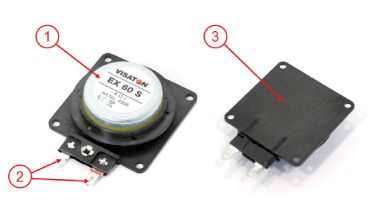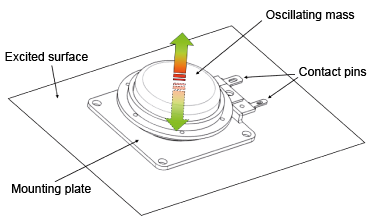
| DE | EN | Contact | About us | Terms of Business | Imprint | Privacy & Cookies | Help | Newsletter | Registration | Login | |
 |  |  |  |  |  |  |  |  |  |  |  |
| Home > News > Case Studies > Passive and Electromechanical > How does an exciter work? | |||||||||||
How does an exciter work?Schukat explains their functionality, installation, advantages and disadvantages
What is the technology behind a Visaton exciter, how is it installed, and what are the advantages and disadvantages of these vibration transducers?An exciter (a.k.a. vibration transducer, bodyshaker), as a loudspeaker without a membrane, comprises three essential components: an oscillating mass (1), a contact terminal (2) for electrical connection to the amplifier, and a mounting plate (3) for fixing to the installation surface.
Similarity to a loudspeaker:By applying a signal to the contact terminal, the oscillating mass vibrates. The vibration is transmitted to the mounting plate and is passed on to the plate to be excited. The excited plate then emanates the music or speech signal. In this respect, the function of an exciter is similar to that of a standard loudspeaker.
Difference to a loudspeaker:he sound emission of the exciter works on a slightly different principle. Compared to a conical and very light loudspeaker membrane, the heavy, flat plate to be excited can hardly vibrate in a piston-like manner. Instead, bending waves, i.e. wave-like oscillations that emit sound, spread out across the excited plate. The quality of the music or speech signal reproduced depends very much on the material, dimensions and shape of the plate to be excited. Correct installation• Mounting method: Depending on type, the exciter is fixed to the installation surface using adhesive and/or screws, ideally on a flat, clean surface, with its entire base plate flat. The adhesive has to suit the material of the installation surface. High-strength contact adhesive, silicone, high-quality double-sided adhesive tape with long-term stability, etc. are all suitable. Exciters with a threaded bushing instead of a mounting plate require a matching threaded bolt that, in turn, is well fastened to the installation surface. Which mounting plate?• The larger the plate, the more low-frequency sound components are reproduced and the "fuller" the sound. Conversely, with smaller plates the sound is "thinner." Pros and cons of exciter technologyDisadvantages Schukat electronicWe offer a range of exciters of manufacturer and speaker specialist Visaton direct from stock |
|


